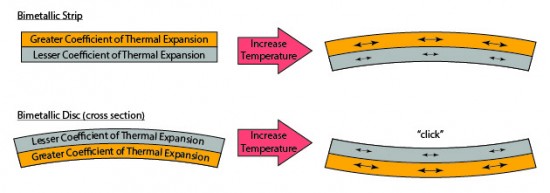In the preceding blog we looked at the expansion and contraction of liquids as a means of measuring temperature. The expansion and contraction of solids (usually metals) is another way to measure temperature.
Most solids expand and contract in a relatively linear way in response to temperature changes. In most cases, solids expand as they are heated and contract as they are cooled. The amount of expansion and contraction of solids (the coefficient of thermal expansion) is typically measured in inches per inch per degree Fahrenheit (or the metric equivalent) and, for common materials, is usually less than 100 times 10 to the minus 6th inches per inch per degree of temperature change. Because of this very small change in dimension, using a direct observation of the expansion and contraction of a solid to measure even relatively large changes in temperature is quite difficult and impractical. Solids, obviously, will not travel up a capillary tube as described for liquids in the preceding blog. There are, however, ways to magnify these small changes in the dimension of solids that make them practical as a means of measuring temperature changes.
The elegant solution is to use two pieces of solid material (usually metals) with differing coefficients of thermal expansion that are fused together as shown in the illustration below.

As a bimetallic sensor is heated, the two solid materials expand at different rates which causes the composite strip or disc to deform in order to equalize internal forces. Depending on the materials used, this deformation can be thousands of times greater than the actual growth of either of the materials the bimetallic is composed of by itself. This larger motion makes measuring temperatures by using the expansion and contraction of solids practical.
In the case of a bimetallic strip, the motion of the bimetallic can be further amplified by forming the strip into a spiral. With one end of the spiral fixed, the tightening and relaxation of the other end can be used to measure temperature changes directly. If the outer end of the spiral is fixed, the center of the spiral will rotate with temperature change. This rotation can be used directly to measure changes by adding a pointer. An everyday example of this is a simple dial thermometer which can be purchased in any hardware store. If the inner end of the spiral is fixed, the outer end will rotate. Thermostats used to control home heating systems often use this motion to tilt a mercury switch which controls the heat source.
Bimetallic discs deform with changes in temperature causing the center of the disk to be displaced perpendicular to the plane of the disc. This is the principle behind the operation of common “click disc” thermostats. Although commonly used to indicate that a target temperature has be achieved in an on/off control system, when properly designed, the disc will remain deformed even when the heat source is removed until it is mechanically returned to the initial position or “reset” making them useful in “safety” applications. In most cases these click devices are pre-calibrated to actuate or “click” at a single temperature. Devices using a bimetallic strip, however, are usually adjustable and can be calibrated to indicate a range of temperatures.
In general, bimetallic sensors are best used in applications requiring the measurement of the temperature of air. Occasionally, the disc type sensors are applied to surfaces but, in fact, are measuring the temperature of the air near the surface and not the temperature of the surface itself.
Upcoming blogs will discuss the use of changes of electrical properties of materials to measure temperature.
– FJF –



 English
English Spanish
Spanish Chinese
Chinese Canada
Canada Mexico
Mexico United Kingdom
United Kingdom



